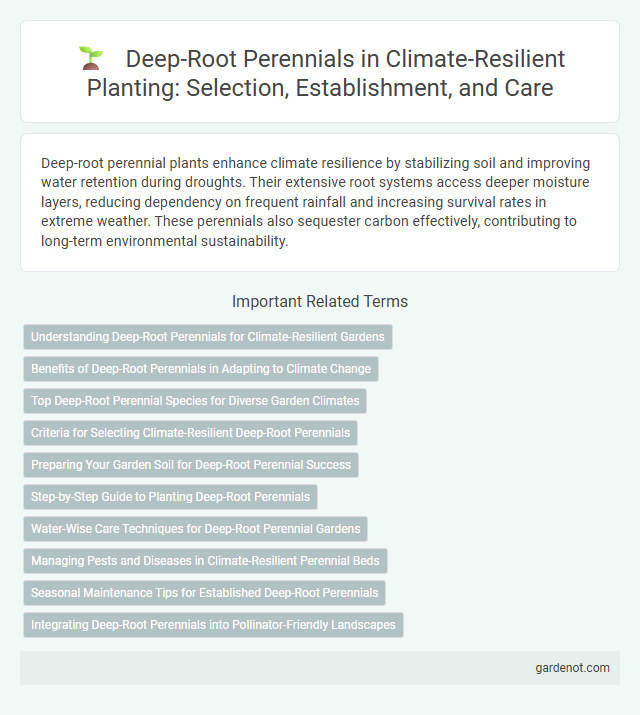Deep-root perennial plants enhance climate resilience by stabilizing soil and improving water retention during droughts. Their extensive root systems access deeper moisture layers, reducing dependency on frequent rainfall and increasing survival rates in extreme weather. These perennials also sequester carbon effectively, contributing to long-term environmental sustainability.
Understanding Deep-Root Perennials for Climate-Resilient Gardens
Deep-root perennials enhance climate resilience by developing extensive root systems that improve soil structure and access deep water reserves, reducing drought stress. These plants sequester carbon effectively and increase biodiversity, contributing to ecosystem stability amid climate fluctuations. Choosing native and drought-tolerant deep-root perennials optimizes garden sustainability and long-term environmental benefits.
Benefits of Deep-Root Perennials in Adapting to Climate Change
Deep-root perennials enhance soil stability by developing extensive root systems that reduce erosion and improve water infiltration during extreme weather events. Their deep roots enable access to groundwater reserves, increasing drought resistance and sustaining plant growth in fluctuating climates. These plants also sequester significant amounts of carbon in deeper soil layers, contributing to long-term climate change mitigation efforts.
Top Deep-Root Perennial Species for Diverse Garden Climates
Deep-root perennial species like switchgrass (Panicum virgatum), eastern purple coneflower (Echinacea purpurea), and black-eyed Susan (Rudbeckia hirta) enhance climate resilience by stabilizing soil and improving water retention across diverse garden climates. These species develop extensive root systems that penetrate deep into the soil profile, promoting drought tolerance and reducing erosion in fluctuating weather conditions. Selecting top deep-root perennials tailored to local climate zones supports sustainable landscaping and long-term ecosystem health.
Criteria for Selecting Climate-Resilient Deep-Root Perennials
Selecting climate-resilient deep-root perennials requires prioritizing species with extensive root systems that enhance soil stability and water uptake during drought conditions. Key criteria include drought tolerance, root depth exceeding 1 meter, and adaptability to local soil types and temperature fluctuations. Perennials with high carbon sequestration potential and resistance to pests and diseases also contribute significantly to long-term ecosystem resilience.
Preparing Your Garden Soil for Deep-Root Perennial Success
Preparing your garden soil for deep-root perennial success involves enriching the soil with organic matter to improve structure and nutrient retention. Loosening the soil to a depth of at least 18 inches promotes extensive root penetration, essential for climate-resilient planting. Incorporating compost and well-balanced fertilizers supports the development of deep, robust root systems that enhance drought tolerance and long-term plant health.
Step-by-Step Guide to Planting Deep-Root Perennials
Start by selecting deep-root perennial species suited to your local climate zone and soil type, ensuring drought tolerance and resilience. Prepare the planting site by loosening soil to a depth of at least 18 inches, incorporating organic compost to improve nutrient content and water retention. Plant seedlings at appropriate spacing to encourage deep root growth, water thoroughly, and mulch to conserve moisture and suppress weeds, promoting long-term climate resilience.
Water-Wise Care Techniques for Deep-Root Perennial Gardens
Deep-root perennial gardens enhance climate resilience by efficiently accessing deep soil moisture, reducing the need for frequent irrigation. Water-wise care techniques include mulching to retain soil moisture, targeted drip irrigation to minimize water waste, and selecting drought-tolerant species that thrive with minimal water. These practices conserve water resources while promoting healthy root systems and sustained plant growth under variable climate conditions.
Managing Pests and Diseases in Climate-Resilient Perennial Beds
Deep-root perennial plants enhance pest and disease management in climate-resilient beds by improving soil health and creating a stable microenvironment that discourages pest infestations and disease outbreaks. Their extensive root systems support beneficial soil microbes and predators that naturally suppress harmful pests, reducing the need for chemical interventions. Incorporating deep-root perennials into planting schemes helps maintain ecological balance, ensuring durable resistance against climate-induced stressors.
Seasonal Maintenance Tips for Established Deep-Root Perennials
Established deep-root perennials thrive with seasonal maintenance that includes mulching to conserve moisture and prevent weed growth, essential for climate resilience. Regularly inspect root zones for pests or signs of disease, ensuring prompt treatment to maintain plant health. Pruning dead or damaged foliage during dormancy enhances nutrient allocation to deep roots, supporting sustained growth through varying climate conditions.
Integrating Deep-Root Perennials into Pollinator-Friendly Landscapes
Deep-root perennials enhance pollinator-friendly landscapes by improving soil health and increasing water retention through their extensive root systems. These plants provide consistent nectar and habitat for pollinators such as bees, butterflies, and hummingbirds, supporting biodiversity in climate-resilient gardens. Integrating deep-root perennials like echinacea, bee balm, and goldenrod contributes to ecosystem stability while promoting sustainable water management.
Deep-root perennial Infographic

 gardenot.com
gardenot.com